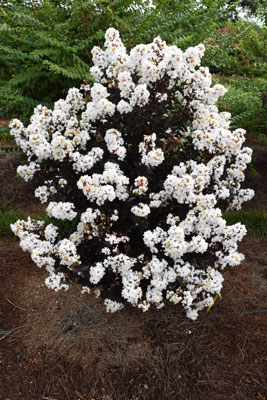4/1/2018
Do You Believe in Magic?
Katie Elzer-Peters

Visit the South and you’d be hard pressed to drive more than a mile or two without seeing crape myrtles in the traffic medians or in island landscape beds. Drive around in January or February and you’re also likely to see trunks of crape myrtles that have been chain-sawed in half, leaving only 3-, 5-, or 7-ft. tall stumps. Crape murder is a widespread crime that goes unprosecuted everywhere warmer than Zone 7.
With the Magic series of crape myrtles, a flagship plant of the First Editions program, Bailey Nurseries aims to change that. No, not to prosecute, but to take away the ammunition. There’s no need to get out the chainsaw when you can plant crape myrtles that, rather than reaching 30-ft. plus, naturally stay in the 6- to 16-ft. range, depending on the plant.
The Magic series of crape myrtles includes eight named hybrids with flowers in shades of pink, purple and white, and with green or purple leaf colors.
Pictured: Like the rest of the Magic family, Purple Magic is highly resistant to leaf spot and powdery mildew.
It all started when Delta Jazz, a purple-leafed, pink-flowering crape myrtle hit the market in 2010. Unlike dark-leafed crape myrtles before it, this one’s leaves stayed dark all summer long. Breeders snapped up the genetics and started working with them to create new series. Dr. Michael Dirr—through his company, Plant Introductions, Inc.—began breeding and selecting. The goal: an intermediate-sized crape myrtle that didn’t require constant pruning.
In 2012-2013 the first Magic Crape Myrtles—Midnight Magic, 4- to 6-ft. tall with salmon pink flowers, and Moonlight Magic (8- to 12-ft. tall), with white flowers—hit the market. In addition to their good behavior in the landscape, they arrived with high disease resistance, a dark leaf color that persists until fall and high bloom counts.
Bailey Nurseries acquired Dr. Dirr’s company, Plant Introductions, Inc. in 2015. In 2017, they rebranded this breeding and product development arm as “Bailey Innovations” and purchased a 35-acre location in Winterville, Georgia, to serve as a primary research and development facility.
 Pictured: Lunar Magic is a dark-leafed crape myrtle that can rebloom multiple times after being trimmed back.
Pictured: Lunar Magic is a dark-leafed crape myrtle that can rebloom multiple times after being trimmed back.
David Roberts is the head breeder of Bailey Innovations and works with the Magic series, developing new varieties to add to the collection. He says, “Most people dream of inheriting an amazing set of germplasm like this. It’s an incredible collection of crape myrtles with reblooming characteristics, a variety of leaf colors, plant sizes and shapes, disease resistance, and more.”
What’s coming up? He’s careful not to give too much away, saying only, “We have recovered interesting phenotypes, or physical characteristics, from the germplasm. We’re seeing some different shapes and sizes from anything that is out there right now.”
Any “crazy shapes,” or just new shapes and interesting growth habits, will be carefully evaluated against hallmark traits of the collection, extreme resistance to cercospora leaf spot and powdery mildew, persistent dark foliage that lasts all summer and masses of blooms. Since taking over the breeding, David and colleagues have noticed something tricky about dark foliage cultivars.
“Their leaves tend to curl up, so you don’t get a big impact.” They’re ruthless when culling the trial plantings. Any trace of folded leaves or cercospora and the plant is immediately yanked. “It has to check all of the boxes to stay.”
It’s great when a breeder is excited about a plant, but for a variety to have legs at retail, the grower, retailer and consumers have to embrace it, too. Natalia Hamill, Brand & Business Development Manager for Bailey Nurseries, says the Magics have found their audience, in part, because of their staggering bloom power.
“Most of the bigger crape myrtle varieties don’t bloom well in pots. Magics do. The growers can ship them to retail in full bloom.”
Customers don’t have to envision what the flowers will look like from a picture on the tags. When they see the flashy blooms in front of them, plants fly off the shelves.
“Usually a dwarf or less-vigorous variety of plant won’t deliver the flower power,” she says. “Magics are known for their abundant blooms and their smaller stature.”
For More Info
To find a grower, email Natalia Hamill at natalia.hamill@baileynursery.com.
Magics also rebloom, giving growers and retailers flexibility in timing of sales. “We’re always looking for earlier-flowering crape myrtles and crapes that will re-bloom,” says David. The newest introduction to the series, Lunar Magic, did something that, he says, “I’ve never seen on a flowering crape myrtle, period.”
They went to take cuttings from the plant for propagation. Six weeks later, after completely trimming back the entire plant, it was in full bloom again. They returned a second time, repeated the hard cutback and found the plant in full flower yet again. Three huge cycles of bloom in one growing season. “It was really exciting to see that potency on a reblooming plant,” said David.
Fast finish times, natural intermediate size, big flowers, healthy, shiny leaves, disease resistance and multiple bloom cycles per summer. You could say these plants are magic. GP
Katie Elzer-Peters is a garden writer and owner of The Garden of Words, LLC, a marketing and PR firm handling mostly green-industry clients. Contact her at Katie@thegardenofwords.com or at www.thegardenofwords.com.